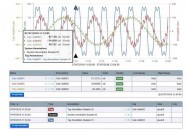 In today’s processing environment, modern batch systems must account for the growing need for flexible, scalable solutions, true distribution of control, and responsive functionality. To address this, Rockwell Automation has introduced its new SequenceManager solution, which enables powerful and flexible sequencing capabilities of the batch process at the controller, offering increased functionality for skids, off-network systems and single-unit controls.
In today’s processing environment, modern batch systems must account for the growing need for flexible, scalable solutions, true distribution of control, and responsive functionality. To address this, Rockwell Automation has introduced its new SequenceManager solution, which enables powerful and flexible sequencing capabilities of the batch process at the controller, offering increased functionality for skids, off-network systems and single-unit controls.
Leveraging a Logix-based controller platform from Rockwell Automation, the SequenceManager solution allows operators to configure, view and obtain critical information about batch sequences stored in the controller, increasing visibility and accessibility to all stages of the production process.
“The SequenceManager solution allows the user to deliver fast and reliable sequence execution while reducing infrastructure costs for standalone units and complete skid-based system functionality,” says Dan UpDyke, product manager, Rockwell Automation. “This scalable solution brings plantwide control capabilities of a modern batch control, for both small and medium-sized operations.”
Key capabilities of the solution include:
- Intuitive operations – Modern interfaces, workflows and accessibility features empower operators to focus on production needs instead of managing system navigation and manual interventions, and view standardized batch reporting for seamless integration with other Rockwell Automation products.
- Highly scalable architecture – OEMs can develop, test and deliver skids as fully functioning, standalone equipment that can seamlessly integrate into a site’s existing batch strategy without the need to redeploy the code. End users will realize efficiencies in integration and reduced infrastructure costs that traditional batch solutions may normally require.
- Flexible, yet secure – Takes advantage of ISA-88 standard methodologies and state transitions, while getting all of the security and benefits of Rockwell Software Studio 5000 Logix Designer and FactoryTalk View SE software from Rockwell Automation.
- Increased responsiveness – Placing the recipe and sequencing in the controller enables the SequenceManager solution to control high-speed and time-dependent processes through rapid response and secured connectivity.

 National Instruments, the provider of platform-based systems that enable engineers and scientists to solve the world’s greatest engineering challenges, today announced LabVIEW 2016 system design software, empowering engineers to simplify development and effectively integrate software from the ecosystem into their systems. The latest version of LabVIEW introduces new channel wires to simplify complex communication between parallel sections of code. Available on both desktop and real-time versions of LabVIEW, the channel wire method helps improve code readability and reduces development time.
National Instruments, the provider of platform-based systems that enable engineers and scientists to solve the world’s greatest engineering challenges, today announced LabVIEW 2016 system design software, empowering engineers to simplify development and effectively integrate software from the ecosystem into their systems. The latest version of LabVIEW introduces new channel wires to simplify complex communication between parallel sections of code. Available on both desktop and real-time versions of LabVIEW, the channel wire method helps improve code readability and reduces development time. Yokogawa Electric Corporation announces the July 13 release of an update to the Exaquantum™ plant information management system (PIMS). Release R3.02 provides improved web and data analysis functions that will enhance plant operations.
Yokogawa Electric Corporation announces the July 13 release of an update to the Exaquantum™ plant information management system (PIMS). Release R3.02 provides improved web and data analysis functions that will enhance plant operations. Designed for use in the oil and gas industries, the Rotork ELB is a robust, self-contained instrument that combines pipeline pressure monitoring with intelligent valve control. The ELB can also collect detailed operational data for optimising performance and enhancing pipeline safety.
Designed for use in the oil and gas industries, the Rotork ELB is a robust, self-contained instrument that combines pipeline pressure monitoring with intelligent valve control. The ELB can also collect detailed operational data for optimising performance and enhancing pipeline safety. Siemens has expanded its cellular router portfolio by adding the Ruggedcom RM1224 as an entry level device. The Ruggedcom RM1224 with its 4G LTE worldwide connectivity and automatic fallback to 3G UMTS or EVDO cellular networks is ideally suited for providing data communication to and from remote locations. Thanks to its high bandwidths and performance capabilities the Ruggedcom RM1224 wireless router can be deployed in a diverse range of applications: from the integration of remote substations and feeder devices to rail wayside applications and mobile Intelligent Transportation Systems (ITS), as well as remote video surveillance.
Siemens has expanded its cellular router portfolio by adding the Ruggedcom RM1224 as an entry level device. The Ruggedcom RM1224 with its 4G LTE worldwide connectivity and automatic fallback to 3G UMTS or EVDO cellular networks is ideally suited for providing data communication to and from remote locations. Thanks to its high bandwidths and performance capabilities the Ruggedcom RM1224 wireless router can be deployed in a diverse range of applications: from the integration of remote substations and feeder devices to rail wayside applications and mobile Intelligent Transportation Systems (ITS), as well as remote video surveillance. Moxa is pleased to announce that its rugged EXPC-1519 panel computer has received the stand-alone certification from UL, ensuring that the EXPC-1519 can operate safely in hazardous areas as defined by their respective standards: Class I, Division 2 for the North American standard, and Zone 2 for both the ATEX and IECEx standards. The certifications confirm that the panel computer is ideally suited for operation in oil & gas, petrochemical manufacturing, and other hazardous locations and industrial applications where explosive atmospheres may be present.
Moxa is pleased to announce that its rugged EXPC-1519 panel computer has received the stand-alone certification from UL, ensuring that the EXPC-1519 can operate safely in hazardous areas as defined by their respective standards: Class I, Division 2 for the North American standard, and Zone 2 for both the ATEX and IECEx standards. The certifications confirm that the panel computer is ideally suited for operation in oil & gas, petrochemical manufacturing, and other hazardous locations and industrial applications where explosive atmospheres may be present. Many manufacturers rely on system integrators to design and install compliant machinery safety solutions, but they often struggle to find the most capable provider. To help ease that process, Rockwell Automation continues to expand its global Machinery Safety System Integrator program. Three new members have joined in the first half of 2016, bringing the total number to 26.
Many manufacturers rely on system integrators to design and install compliant machinery safety solutions, but they often struggle to find the most capable provider. To help ease that process, Rockwell Automation continues to expand its global Machinery Safety System Integrator program. Three new members have joined in the first half of 2016, bringing the total number to 26. Yokogawa Electric Corporation announces that its subsidiary, Yokogawa Electric Korea, has received an order to deliver control systems for a new plant that S-Oil Corporation, a Korean oil & gas subsidiary of Saudi Aramco, plans to build at its Onsan refinery complex in the city of Ulsan. The control systems are for a residue fluid catalytic cracker (RFCC)* and auxiliary facilities that will produce mainly polypropylene and propylene oxides.
Yokogawa Electric Corporation announces that its subsidiary, Yokogawa Electric Korea, has received an order to deliver control systems for a new plant that S-Oil Corporation, a Korean oil & gas subsidiary of Saudi Aramco, plans to build at its Onsan refinery complex in the city of Ulsan. The control systems are for a residue fluid catalytic cracker (RFCC)* and auxiliary facilities that will produce mainly polypropylene and propylene oxides. Moxa is pleased to launch the industrial Ethernet extender switch, IEX-408E-2VDSL2, to address the growing networking extension requirements driven by the Industrial Internet of Things (IIoT) trend. The IEX-408E-2VDSL2 supports two VDSL2 ports and 6 Ethernet ports for long distance data transmission over twisted-pair copper wiring. This product enables users to leverage existing cables to upgrade and extend their networks quickly as well as reduce costs making it ideally suited to intelligent transportation systems, Oil & Gas, factory automation, and mining industries.
Moxa is pleased to launch the industrial Ethernet extender switch, IEX-408E-2VDSL2, to address the growing networking extension requirements driven by the Industrial Internet of Things (IIoT) trend. The IEX-408E-2VDSL2 supports two VDSL2 ports and 6 Ethernet ports for long distance data transmission over twisted-pair copper wiring. This product enables users to leverage existing cables to upgrade and extend their networks quickly as well as reduce costs making it ideally suited to intelligent transportation systems, Oil & Gas, factory automation, and mining industries.